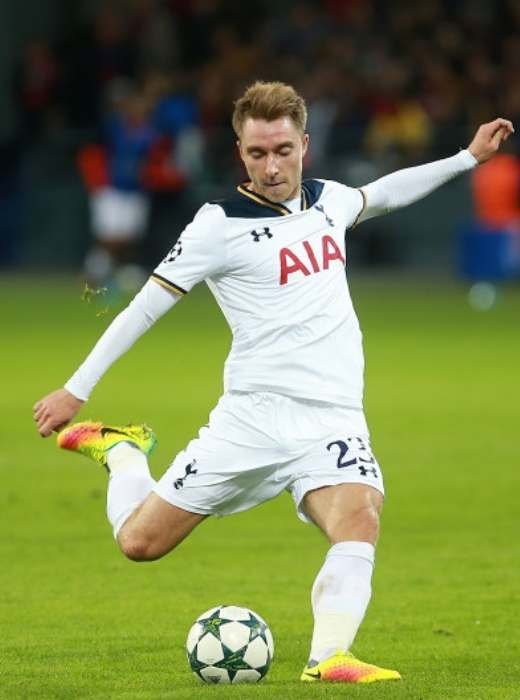The crisp summer air hung over Copenhagen’s Parken Stadium on June 12, 2021. For Danish midfielder Christian Eriksen, it was meant to be another proud moment representing his country at Euro 2020. Instead, it became the day that would forever divide his life into before and after. As the clock approached halftime against Finland, Eriksen collapsed suddenly on the pitch. The world watched in horror as medical staff performed CPR, fighting to restart his heart that had stopped beating.
“In that moment, he was gone,” Danish team doctor Morten Boesen would later tell BBC Sport. “For five minutes, he was gone from this world.”
What followed was not just a medical miracle but a testament to human resilience – a journey from the brink of death back to the pinnacle of world football. This is the story of a man who refused to let tragedy define him, whose comeback reminds us of sport’s power to inspire beyond any scoreline.
Christian Eriksen’s Early Beginnings: The Foundation of a Champion
A Danish Childhood Shaped by Football
Christian Eriksen’s story begins far from the spotlight, in the quaint coastal town of Middelfart, Denmark, where he was born on February 14, 1992. The son of Thomas and Dorthe Eriksen, his introduction to football came almost as soon as he could walk. By age three, a small Eriksen was already kicking a ball around his father’s local team practices.
“I always had a ball,” Eriksen told the media in a 2018 interview. “If we went to the supermarket, I’d be dribbling down the aisles. If we were out with friends, I’d be the one wanting to play football.”
In Middelfart, a town of just over 15,000 people, football was more than recreation – it was community. Christian Eriksen’s father Thomas coached at the local club, creating an environment where young Christian could nurture his burgeoning passion. Hours spent on makeshift pitches and backyard games laid the foundation for extraordinary technical skills that would later define his professional career.
Rising Through Danish Youth Football
As Christian Eriksen’s talent became unmistakable, he joined Middelfart G&BK, his hometown club. Even among peers, his vision and ball control stood out. By age 13, bigger opportunities beckoned, leading him to join Odense Boldklub (OB), one of Denmark’s most prestigious youth academies.
The move to OB marked his first significant step toward a professional career, but it also presented challenges. Despite his obvious technical gifts, scouts continually questioned his slight physical frame. Standing at just 5’8″ as a teenager with a slim build, Eriksen heard the same criticism repeatedly: too small, too fragile for the physical demands of top-tier football.
Rather than discouraging him, these doubts fueled Eriksen’s determination. He compensated for his stature by developing extraordinary spatial awareness, an almost preternatural ability to find space where none seemed to exist, and precision passing that could unlock the tightest defenses.
By 16, Christian Eriksen’s reputation had transcended Denmark as he caught the attention of European giants, with Chelsea and Barcelona inviting the teenager for trials. However, it was Ajax Amsterdam, the legendary Dutch club renowned for developing young talent, who secured his signature in 2008 – a decision that would prove transformative for the young Dane’s development.
Overcoming Adversity: Christian Eriksen’s Battle with Cardiac Arrest
The Day Football Stood Still
June 12, 2021, began as a celebration of football’s return after the pandemic-delayed European Championship. For Christian Eriksen, it marked his 109th appearance for Denmark. Forty-two minutes into the match against Finland, with no contact from another player, Christian Eriksen suddenly collapsed face-first onto the turf. What followed were moments that transcended sport.
Team captain Simon Kjaer was first to reach Eriksen, placing him in the recovery position and ensuring he didn’t swallow his tongue. Within seconds, medical staff rushed onto the field. As they began CPR, Danish players formed a protective human shield around their fallen teammate, many visibly distraught, some in tears. The stadium fell into a stunned silence.
“We got him back after one defib,” Denmark’s team doctor Morten Boesen later told. “That’s quite fast.”
After approximately ten minutes of emergency treatment on the field, Eriksen was stretchered off, conscious but fragile. The haunting image of his raised hand as he left the pitch offered a glimmer of hope amid the darkness. Later that evening, the Danish Football Association confirmed that Eriksen was stable in hospital, though the severity of his condition was unmistakable: he had suffered a cardiac arrest, and his heart had stopped beating.
Medical Aftermath and Career Uncertainty
The days following the incident revealed the extent of Eriksen’s condition. Doctors determined he required an Implantable Cardioverter Defibrillator (ICD) – a small device placed under the skin to monitor heart rhythm and deliver electric shocks when necessary to prevent fatal cardiac arrests.
While the device would protect Christian Eriksen’s life, it cast immediate doubt on his football future. Italian medical regulations prohibit athletes with cardiac devices from competing in professional sports. As a result, Eriksen’s contract with Inter Milan was terminated by mutual consent in December 2021, ending a chapter of his career that had barely begun.
“There was a time I didn’t care about football,” Eriksen admitted to BBC. “All I wanted was to be alive and spend time with my family.”
For an athlete at the peak of his powers – a player who had shone for Tottenham Hotspur in the Premier League and won a Serie A title with Inter Milan – the prospect of retirement at 29 seemed cruelly premature. Many experts and former players suggested Eriksen should prioritize his health and accept his playing days were over.
Finding Strength in Uncertainty
As his physical recovery progressed, Eriksen began a quieter, more personal battle. “The first three months, I couldn’t do anything,” he told The Athletic. “You couldn’t walk the dog, you couldn’t do anything that raised your heart rate.”
During this period, Christian Eriksen returned to his former club Odense Boldklub to train alone, away from media attention. These solitary sessions became a form of therapy – each completed drill, each successful sprint a small victory against the uncertainty that clouded his future.
The journey back required medical consultations across Europe. Cardiologists in Denmark and Belgium performed extensive tests to determine if his condition would allow a return to play. Against the backdrop of medical caution, Eriksen harbored a quiet determination. “My goal was always to come back,” he later told BBC Sport. “It was just a question of whether it was realistic.”
By December 2021, six months after his collapse, medical specialists gave Eriksen the news he had been hoping for: with the ICD functioning properly and no subsequent cardiac issues detected, a return to professional football was possible – just not in Italy.
Christian Eriksen’s Pivotal Moments: From Near-Death to Triumphant Return
The Road Back to Professional Football
As 2022 began, speculation swirled about Eriksen’s future. Having been cleared by doctors to resume his career, the question remained: which club would take a chance on a player who, despite his immense talent, carried such medical history?
The answer came from an unexpected source. Brentford FC, a recently promoted Premier League club, offered Eriksen a six-month contract in January 2022. The connection was meaningful – Brentford’s manager Thomas Frank was Danish, and the club had several Danish players. Additionally, the Premier League had no regulations preventing players with ICDs from competing.
“Sometimes life gives you lemons, sometimes it gives you Christian Eriksen,” Brentford announced when confirming the signing that shocked and delighted the football world in equal measure.
The move represented more than a new club – it symbolized a second chance at the career that had been nearly snatched away. “I want to prove I’ve still got it,” Eriksen told Brentford’s club media. “My heart is not an obstacle.”
A Comeback for the Ages
On February 26, 2022, just 259 days after his cardiac arrest, Christian Eriksen made his return to professional football, coming on as a substitute against Newcastle United. Parken Stadium had fallen silent during his collapse; now, the Brentford Community Stadium rose in a standing ovation that transcended team loyalties.
The emotion of the moment was palpable, but what followed in the coming weeks astonished even the most optimistic supporters. Christian Eriksen didn’t just return – he excelled. His vision and passing range remained intact, his set-piece delivery as dangerous as ever. In his third start for Brentford, he scored against Chelsea, his first goal since his cardiac arrest.
By season’s end, Eriksen had registered a goal and four assists in just 11 appearances, helping Brentford secure their Premier League status. According to Premier League statistics, Brentford averaged 1.9 points per game with Eriksen in the starting lineup, compared to just 0.93 point per game without him – stark evidence of his immediate impact.
“What happened to me changes your perspective on everything,” Eriksen told The Times. “I’m just appreciating that I can kick a ball again, that I can be part of a dressing room again, that I can be part of a team again.”
Return to Elite Competition
Eriksen’s performances at Brentford attracted attention from bigger clubs, and in July 2022, he signed with Manchester United, marking a full circle return to elite European football. The three-year contract represented not just faith in his abilities but in his medical stability.
“Manchester United is a special club,” Eriksen said during his official unveiling. “I still have ambitions in the game, there is a lot more I want to achieve.”
His return to international football completed the comeback story. In March 2022, Eriksen not only rejoined the Danish national team but scored within minutes of coming on as a substitute against the Netherlands – at the very stadium where he had begun his professional career with Ajax.
Christian Eriksen’s Legacy: Inspiring Change Through Resilience
Advocacy for Cardiac Health Awareness
Beyond his on-field achievements, Eriksen has embraced a new role as an advocate for cardiac health awareness. His experience dramatically highlighted the importance of immediate CPR and access to defibrillators – interventions that saved his life.
Working with the Danish Heart Foundation, Eriksen has supported initiatives to increase CPR training and the availability of defibrillators in public spaces. “If it can happen to me, it can happen to anyone,” he often emphasizes in his advocacy work.
His story has already had tangible impacts. According to the Danish Heart Foundation, there was a 190% increase in sign-ups for CPR courses in the month following Eriksen’s collapse – a spike that represents potential lives saved in the future.
What makes Eriksen’s story particularly powerful is that he hasn’t merely returned—he’s continued to perform at an elite level. Each precise pass, each match-winning contribution serves as testament to resilience that transcends sport.
Continuing to Inspire Through Performance
Today, Eriksen continues to challenge assumptions about athlete recovery. At Manchester United, he has established himself as a valuable squad member, bringing creativity and experience to one of the world’s most scrutinized teams.
His presence on the pitch remains a weekly reminder of what’s possible when medical science, personal determination, and institutional support align. Every minute he plays serves dual purposes: contributing to his team’s success while simultaneously inspiring countless individuals facing their own health challenges.
“People sometimes forget what I went through because I’m back playing. That’s the beautiful part – that I’m back playing. But for me, there will always be that split second where everything can change. I’m just appreciating every moment now.”
The Ongoing Journey
For football fans, Eriksen remains a player of extraordinary vision and technique. For the medical community, he represents an exceptional case study in cardiac recovery. But for countless individuals facing their own physical challenges, he symbolizes something even more profound: the possibility that adversity – even the most life-threatening kind – need not define one’s future.
“I’ve been given a second chance,” Eriksen says simply. In using it as he has, he’s given something invaluable to others: the courage to believe in their own second chances, whatever form they might take.”
Have you been inspired by Christian Eriksen’s journey? Learning CPR could help you save a life someday, just as it saved his. Contact your local heart foundation today to find training courses near you, and be part of ensuring that more cardiac arrest stories have happy endings.
In the pantheon of sports’ most inspiring comebacks, Eriksen’s journey echoes another remarkable tale of medical trauma transformed into triumph, that of German rower Kathrin Marchand. Just as Eriksen faced a heart stoppage on that fateful day in Copenhagen, Marchand experienced her own brush with mortality through a stroke that threatened not just her athletic career, but her very survival. Read her story here: Kathrin Marchand: Rowing against the Tide
Photo by: By Дмитрий Голубович – soccer.ru, CC BY-SA 3.0,




